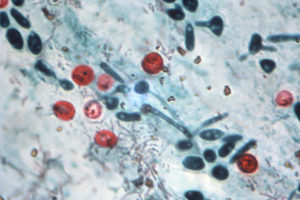Swimming Pools, Hot Tubs, and Other Summer Recreational Water Hazards

Is nothing safe anymore? Just in time for summer fun, the CDC announced an increase in infections from swimming pools and hot tubs. In their new Morbidity and Mortality Weekly Report (MMWR), the CDC announced that cases of a parasite, cryptosporidium, had increased approximately 13 percent each year between 2009–2017, with 444 outbreaks reported in total.
Cryptosporidium is a single-celled organism, a protozoan. It causes diarrhea that often lasts for two to three weeks and is readily missed by the lab. This is because often only a stool culture is ordered, and the parasites are instead seen on direct examination of stool through a microscope. Many community hospitals don’t have techs skilled in this and have resorted to sending stool samples “for ova and parasites” to a reference lab, causing further diagnostic delays.
Cryptosporidium is now the leading cause of water-borne outbreaks in the U.S. This parasite made a grand debut in 1993, sickening more than 400,000 people in Milwaukee, Wisconsin—a quarter of the city’s population—and killing sixty-nine, mostly immunocompromised hosts. As a result, many places now filter their water to remove the organism prior to chemical treatment.
More recently, Cryptosporidium has been associated mostly with water parks and swimming pools. This is because even chlorine may not kill the parasite for days. In 2016, the CDC revised recommendations for hyperchlorination because of the parasite’s tolerance of chlorine. On the other hand, the general public is not advised to try that on their own, as improperly handled pool chemicals are dangerous. The CDC also reported a number of cases of chlorine toxicity, resulting in vomiting, coughing, and eye irritation. In 2019, they noted there were over 13,500 visits to emergency departments after pool chemical–associated health events between 2015 and 2017.
Further, between 2000–2014, more than 27,000 people became ill and eight people died from infections from such freshwater pools and hot tubs. A third were acquired at hotels.
“Swallowing just a mouthful of water with Crypto in it can make otherwise healthy kids and adults sick for weeks with watery diarrhea, stomach cramps, nausea, and vomiting,” said Michele Hlavsa, R.N., M.P.H., chief of CDC’s Healthy Swimming Program. She cautioned that because chlorine does not work quickly against cryptosporidium, “Don’t go into the water, and don’t let your kids go into the water, if sick with diarrhea.”
It’s not only cryptosporidium you need to worry about. Other diarrheal diseases may be caused by another parasite, Giardia, often from water contaminated by stool from wild animals. This has particularly been a problem among hikers and campers drinking from “fresh” water streams. Bacteria such as Shigella and E. coli O157:H7 are more likely to cause an acute and often more serious illness; these are more readily detected by labs than the parasites. Norovirus is also sometimes caused by water as well as contaminated food.
Hot tubs have long been a source of infections from a bacterium called Pseudomonas aeruginosa. This water-loving bacteria can cause an infection of the hair follicles, which results in a diffuse rash of small zit-like bumps. Occasionally, people become more generally ill with fever, sore throat, headache or diffuse symptoms. Usually, no treatment is needed. If it doesn’t promptly go away or the person is more seriously ill, a culture of the pus should be sent for sensitivity testing, since there is increasing antibiotic resistance. Prevention is by adequate chlorination of the water.
Other outdoor sports–related water infections warrant attention.
One is leptospirosis, caused by water contaminated by infected urine from rats, mice, raccoons, and cattle most commonly. This bacteria is most commonly associated with whitewater rafting4 and occurs all over the world. It can cause kidney and liver failure.
Naeglaria, the “brain-eating amoeba” of the news, is again acquired from fresh water, more often from warm, stagnant water in the South. There have been rare cases from kiddie pools and one sad case in which an infant likely acquired the infection during a full-submersion baptism ceremony. The parasite doesn’t enter the body by being swallowed, but rather by being snuffed up the nose. That’s also how this infection is acquired from using Neti pots for sinus irrigation with using sterile water.
The final deadly bacteria to remind you about is Vibrio vulnificus. This saltwater bacteria causes deaths each year, most commonly along the Gulf Coast, from cuts or scrapes that become infected. Vibrio causes a fulminant infection with a progressively spreading wound infection and fever; you might see large bloody blisters on the skin. It can lead to shock and death if not aggressively treated.
Prevention
As Tom Lehrer so famously said in his song “Pollution,” “Don’t drink the water and don’t breathe the air.”
Teach your kids not to pee or poop in the water. This also means not letting them swim if they have recently had diarrhea. Also, teach them not to drink it or playfully take mouthfuls to spit at others.
The CDC now advises people to be their own health inspectors by checking a pool’s inspection scores. Limited information may be available online. Remarkably, they also suggest people buy test strips to test pH and free chlorine or bromine concentration. These are available at superstores, hardware stores, and pool-supply stores. Traditional public health tasks are now being turned over to individuals.
My last bit of advice is given as an infectious diseases physician. Many physicians have never seen uncommon infections. Unless you give your physician a careful exposure history, including travel and sports activities or animal contacts, many illnesses are unlikely to be promptly diagnosed and successfully treated.
So enjoy your summer recreation, but do so carefully and be alert to these unusual infections should you require medical care.



